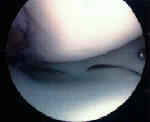- See: Meniscal Menu:


- Discussion:
- medial meniscus is "C shaped", whereas lateral meniscus is is "O shaped" and is more sharply curved;
- medial meniscus is crescentric in structure, but its anterior & posterior extensions have a wider
separation on the lateral articular surface;
- average width is 9-10 mm, and avg thickness is 3-5 mm;
- the meniscus is anchored to the tibia via the meniscotibial (coronary ligaments);
- anterior fibers attach a few mm below periphery of tibial articular surface w/ extension to most posterior aspect of anterior limb to
intercondylar area of the tibia;
- posterior fibers of this anterior limb connect thru transverse ligament, which runs across medial aspect of tibial plateau to connect to
the lateral meniscus;
- mid aspect of medial meniscus is firmly attached to deep MCL;
- posteriorly, medial meniscus is anchored to posterior intercondylar area betaween PCL & to the lateral meniscus;
- the medial meniscus bears upto 50% of medial compartment contact pressures;
- Meniscal Injury:
- types of meniscal tears:
- bucket handle meniscus tear:
- posterior horn tears of medial meniscus:
- mechanism of injury:
- during internal rotation of femur on tibia w/ knee in flexion, femur tends to position medial meniscus posteriorly toward the center of knee joint;
- posterior part of meniscus is caught between femur and tibia, & is torn longitudinally when the joint is suddenly extended;
- Management:
- stable tears:
- stable meniscal tears theoretically have potential for healing and therefore may be treated non operatively;
- these tears include:
- partial thickness tears;
- full thickness vertical (or oblique tears) measuring </= 5-10 mm which displace less than 3 mm into the joint;
- stable radial tears </= 5 mm have a low potential for healing but may be considered for nonsurgical management;
- references:
- Non-operative treatment of meniscal tears
- surgical treatment options: (see arthroscopy of the knee);
- partial meniscectomy:
- menisci trasmit upto 70% of joint loads;
- partial menisectomy may increase peak loads upto 65% whereas total meniscectomy may increase peak loads upto 235%;
- the radiographic consequences of total menisectomy have been characterized by Fairbank and include: joint space narrowing, squaring
of the condyle, and ridge formation;
- medial meniscal repair
- if tear is w/in 3 mm of the periphery, it is considered vascular;
- area 3-5 mm from periphery is grey zone, & > 5 mm from periphery is considered avascular;
- unstable tears or tears within vascular zone that are > 7 mm are repairable;
- the best results in meniscal repair occur w/ concomitant ACL reconstruction
Cysts of the medial meniscus. Arthroscopic diagnosis and management.
Effects of medial meniscectomy in patients older than forty years.
Late results following medial meniscectomy in an older population.
The effect of medial meniscetomy on anterior-posterior motion of the knee.

